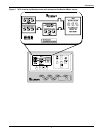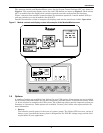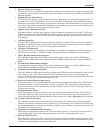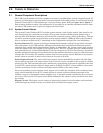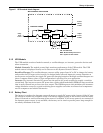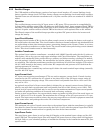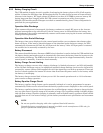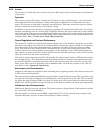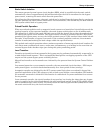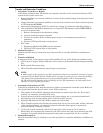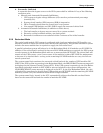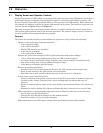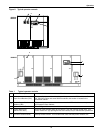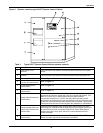
Theory of Operation
15
2.2.4 Inverter
The inverter is a solid state device that converts the DC output of the rectifier/charger or the battery
to AC power.
Operation
The inverter converts DC power—from either the battery or the rectifier/charger—into three pulse-
width-modulated/six-step waveforms. These waveforms are filtered into low-distortion sine wave
power. The inverter is controlled by digitally controlled logic. This logic controls the precise synchro-
nization, amplitude and frequency of the output voltage.
In addition to the inverter efficiently supplying a regulated AC output from a DC source, the output
isolation transformer acts as a second stage of isolation between the critical load bus and the commer-
cial source power. The inverter is configured to handle most critical load inrush surges. It maintains
output voltage Total Harmonic Distortion (THD) within specifications even when handling non-linear
computer loads. Refer to Non-Linear Load Characteristics.
Output Regulation and Overload Performance
The inverter is capable of sustaining full output voltage (±2% of the nominal voltage) for up to 150%
overload at the output for as long as 30 seconds without reducing the output voltage. It can also han-
dle at least 125% of the rated current for up to 10 minutes and 104% of the rated current continu-
ously. The System Control Cabinet (SCC) will transfer the critical load to the bypass source if the
overload exceeds the system capacity or the capacity of the modules on-line. The multi-module over-
load capacity (in terms of percent of rated full load current of modules on-line) is 140% for 20 seconds,
108% for 10 minutes and 104% continuously.
Note that in normal operation the SCC will transfer the load to bypass before a UPS module exceeds
its overload capacity. If an individual module overload condition is sustained (beyond inverter capac-
ity) the UPS module is automatically taken off-line (disconnected from the critical bus) and is shut
down. If the UPS system is operating in the redundant mode, the load may remain on the UPS sys-
tem. Refer to 3.5 - Automatic Operations.
Non-Linear Load Characteristics
Computers and computer equipment with switching power supplies generate non-linear currents rich
in fifth and seventh harmonics.
The inverter pulse-width-modulated/six-step waveform, coupled with the output filter, provides a nat-
ural path for reducing the fifth and seventh harmonic currents produced by the load. The inverter/fil-
ter limits the output voltage THD to less than 5% with up to 100% typical electronic data processing
(EDP) loads. EDP equipment characteristically includes both non-linear and linear load components.
Unbalanced Load Characteristics
Unbalanced loads are actively regulated. The phase-to-phase voltage balance is maintained to within
2%, even with a 50% load imbalance.
The three-phase, root mean square (RMS—approximately 70% of the peak) average voltage is also
regulated through a separate control circuit (phase-to-phase sensing).



